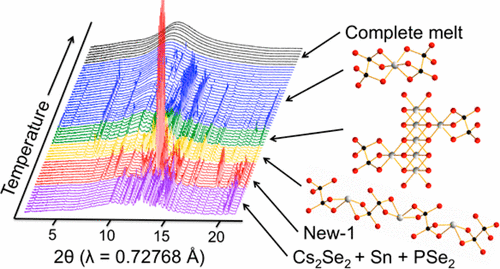当前位置:
X-MOL 学术
›
J. Am. Chem. Soc.
›
论文详情
Our official English website, www.x-mol.net, welcomes your feedback! (Note: you will need to create a separate account there.)
Panoramic Synthesis as an Effective Materials Discovery Tool: The System Cs/Sn/P/Se as a Test Case
Journal of the American Chemical Society ( IF 15.0 ) Pub Date : 2017-07-26 00:00:00 , DOI: 10.1021/jacs.7b05423 Alyssa S. Haynes 1 , Constantinos C. Stoumpos 1 , Haijie Chen 1, 2 , Daniel Chica 1 , Mercouri G. Kanatzidis 1, 2
Journal of the American Chemical Society ( IF 15.0 ) Pub Date : 2017-07-26 00:00:00 , DOI: 10.1021/jacs.7b05423 Alyssa S. Haynes 1 , Constantinos C. Stoumpos 1 , Haijie Chen 1, 2 , Daniel Chica 1 , Mercouri G. Kanatzidis 1, 2
Affiliation

|
The common approach to the synthesis of a new material involves reactions held at high temperatures under certain conditions such as heating in a robust vessel in the dark for a period until it is judged to have concluded. Analysis of the vessel contents afterward provides knowledge of the final products only. Intermediates that may form during the reaction process remain unknown. This lack of awareness of transient intermediates represents lost opportunities for discovering materials or understanding how the final products form. Here we present new results using an emerging in situ monitoring approach that shows high potential in discovering new compounds. In situ synchrotron X-ray diffraction studies were conducted in the Cs/Sn/P/Se system. Powder mixtures of Cs2Se2, Sn, and PSe2 were heated to 650 °C and then cooled to room temperature while acquiring consecutive in situ synchrotron diffraction patterns from the beginning to the end of the reaction process. The diffraction data was translated into the relationship of phases present versus temperature. Seven known crystalline phases were observed to form on warming in the experiment: Sn, Cs2Se3, Cs4Se16, Cs2Se5, Cs2Sn2Se6, Cs4P2Se9, and Cs2P2Se8. Six unknown phases were also detected; using the in situ synchrotron data as a guide three of them were isolated and characterized ex situ. These are Cs4Sn(P2Se6)2, α-Cs2SnP2Se6, and Cs4(Sn3Se8)[Sn(P2Se6)]2. Cs4(Sn3Se8)[Sn(P2Se6)]2 is a two-dimensional compound that behaves as an n-type doped semiconductor below 50 K and acts more like a semimetal at higher temperatures. Because all crystalline phases are revealed during the reaction, we call this approach “panoramic synthesis”.
中文翻译:

全景合成作为有效的材料发现工具:系统Cs / Sn / P / Se作为测试案例
合成新材料的常用方法包括在某些条件下在高温下进行反应,例如在黑暗中于坚固的容器中加热一段时间,直到判断出结论为止。随后对容器内容物的分析仅提供最终产品的知识。在反应过程中可能形成的中间体仍是未知的。对瞬态中间体的这种认识不足,意味着发现材料或了解最终产品的形成方式失去了机会。在这里,我们使用新兴的原位监测方法展示了新结果,该方法显示出发现新化合物的巨大潜力。在Cs / Sn / P / Se系统中进行原位同步加速器X射线衍射研究。Cs 2 Se 2,Sn和PSe的粉末混合物将2个样品加热至650℃,然后冷却至室温,同时从反应过程的开始到结束获得连续的原位同步加速器衍射图。衍射数据转化为存在的相与温度的关系。在实验中,观察到七个已知的结晶相在形成时形成:Sn,Cs 2 Se 3,Cs 4 Se 16,Cs 2 Se 5,Cs 2 Sn 2 Se 6,Cs 4 P 2 Se 9和Cs 2 P 2。硒8。还检测到六个未知阶段。以原位同步加速器数据为指导,对其中的三个进行了非原位分离和表征。这些是铯4的Sn(P 2硒6)2,α-CS 2 SNP 2硒6和Cs 4(SN 3硒8)[Sn的(P 2硒6)] 2。Cs 4(Sn 3 Se 8)[Sn(P 2 Se 6)] 2是一种二维化合物,在50 K以下时表现为n型掺杂半导体,在更高温度下更像半金属。由于所有晶相都在反应过程中显现出来,因此我们将此方法称为“全景合成”。
更新日期:2017-07-28
中文翻译:

全景合成作为有效的材料发现工具:系统Cs / Sn / P / Se作为测试案例
合成新材料的常用方法包括在某些条件下在高温下进行反应,例如在黑暗中于坚固的容器中加热一段时间,直到判断出结论为止。随后对容器内容物的分析仅提供最终产品的知识。在反应过程中可能形成的中间体仍是未知的。对瞬态中间体的这种认识不足,意味着发现材料或了解最终产品的形成方式失去了机会。在这里,我们使用新兴的原位监测方法展示了新结果,该方法显示出发现新化合物的巨大潜力。在Cs / Sn / P / Se系统中进行原位同步加速器X射线衍射研究。Cs 2 Se 2,Sn和PSe的粉末混合物将2个样品加热至650℃,然后冷却至室温,同时从反应过程的开始到结束获得连续的原位同步加速器衍射图。衍射数据转化为存在的相与温度的关系。在实验中,观察到七个已知的结晶相在形成时形成:Sn,Cs 2 Se 3,Cs 4 Se 16,Cs 2 Se 5,Cs 2 Sn 2 Se 6,Cs 4 P 2 Se 9和Cs 2 P 2。硒8。还检测到六个未知阶段。以原位同步加速器数据为指导,对其中的三个进行了非原位分离和表征。这些是铯4的Sn(P 2硒6)2,α-CS 2 SNP 2硒6和Cs 4(SN 3硒8)[Sn的(P 2硒6)] 2。Cs 4(Sn 3 Se 8)[Sn(P 2 Se 6)] 2是一种二维化合物,在50 K以下时表现为n型掺杂半导体,在更高温度下更像半金属。由于所有晶相都在反应过程中显现出来,因此我们将此方法称为“全景合成”。


























 京公网安备 11010802027423号
京公网安备 11010802027423号